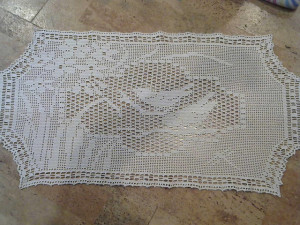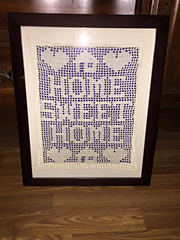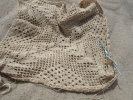Tips for Your First Filet Crochet Piece
By Molly Ferriter – 15 Comments| If you can make a chain stitch and work a double crochet stitch you can make beautiful pieces of art work with filet crochet. Have you wanted to try filet crochet but haven’t taken the plunge yet? Don’t wait any longer! I have some tips for you to get started on this new endeavor! |
My favorite aspect of filet crochet is the abundance of vintage patterns. The picture above is a piece I finished this fall, called the “Laura Ingalls Wilder Doily”, a filet piece crocheted by Laura Ingalls, but originally designed by Mary Card, who was an incredible crochet designer from the early half of the 1900’s. Beautiful antique and vintage patterns are still available for crocheters today. It may sound corny, but I feel like I’m recreating a piece of history when I make them! Filet crochet is also a very modern crochet technique. A quick search on the internet will bring up 1000’s of free filet crochet designs.
You may find it a bit daunting at first, but once you wrap your mind around it, filet crochet is rather easy. If you can crochet chains and double crochets, you can filet crochet!
Filet Crochet Tips for the Beginner:
- Filet crochet is worked from a chart, from the bottom row to the top, so your first row is the bottom row. You will make a foundation chain, then crochet your first row into the foundation chain.
- If you find crochet thread a bit intimidating, read my post Tips from the Doily Nerd: Crocheting Your First Doily for tips on easing into crochet thread.
- Print a copy of the filet crochet chart and highlight or cross off each square and line as you finish them.
- Remember, odd-numbered rows are crocheted right to left, but even number rows go left to right (or vice versa if you are left handed). So make sure to number the rows (front bottom to top). I draw little arrows in each row as I get to them to remind myself which way I am supposed to crochet.
- This cannot be repeated enough: COUNT, COUNT, COUNT, and cross off each block and row as you finish them!
Getting Started: Crocheting the Foundation Chain
As I said above, a filet crochet chart is crocheted bottom to top, so your first row will be the bottom row. It is important to crochet the starting chain- called the foundation chain– correctly. Remember in third grade when you thought, “When will I ever use math in my real life?” Well, people, this is it! To figure out how many chains to crochet in the foundation chain, count the number of squares in the first row (bottom row) and multiply by 3, then add 1. For example, if the bottom row (the first row) has 21 squares, you will multiply 21 X 3, which is 63, then add 1 more, which is 64. In this example you will chain 64 for the foundation chain. You will then chain 2 for the first double crochet in the first row. Now follow the chart.
A Foundation Chain “Cheat”
You may find it difficult to chain the correct number of chains for the foundation chain, especially for a large filet piece. One way to deal with this is to work your foundation chain with a different ball of crochet thread, then work the first row by attaching a different ball into the first chain of your foundation chain. If you only had a “C” in math in elementary school and may have chained the wrong number of chains for the foundation chain, you can add or subtract chains! Brilliant!
Let me know if you have any questions or any filet crochet tips for other Crochetspotters!





This was a very helpful article, and has prompted me to try my first filet crochet piece. However, I wish you had posted a link for a FREE beginner’s filet crochet pattern. Won’t you consider adding a few links to your blog for us eager begginer’s to filet crochet? Thanks very much!
Great suggestion, Donna. I’m so glad you are going to try your first filet crochet piece. It is such a beautiful art form, I’m sure you will love it!
Filet crochet is my favorite, once learn the repeats don’t need pattern – unless a picture then the pattern is required to complete. An easy way is to make a note if going to be where using a pattern is cumbersome. Note has how many open spaces (o) or closed blocks (b). If not square add increase (I) or decreases (d) so instead of big pattern your note would be:
10 (line number) 6o,2c,2o,12c,6o.
Assuming experienced filet and know that an open space is double crochet chain 2 double crochet and a closed appears as 4 double crochets, and 12c would actually be 37 double crochets, To count multiple closed – the count is multiple of 3 plus 1, so one closed is 4, two is 7 (2 time 3 plus one) and 12 ends up being 37 (12 times 3 equals 36 plus 1 equals 37)
I find if don’t count will have a mistake when get to the next row which usually happens at the first of the row so a long redo, frog stitch (ripit ripit)
I love doing the pictures. Its funny, I don’t think I’ve done one filet project that was a pattern, and I’ve seen some beautiful patterns! You’re right about counting- it is so important. Count, count, count!
I am a bit confused. Are you saying the ormula is # of blocks times 3 plus 1 plus 2 more and then double crochet in the 4th chain from hook?
The formula is the # of blocks times 3 plus 1. That is your foundation chain.
Then, you will need to chain to make your turning chain; this depends on whether the first block in your chart is open or closed (solid). If the first block on the chart is a solid mesh, then ch 2, though some people like to ch 3 for a dc turning chain (this counts as the first dc of the first block). If the first block on the chart is an open block, then chain 4 (this counts as the first dc and the ch 2 of the first open block).
I just realized something from my post… I always chain 2 for a dc turning chain, but a lot (maybe most) people chain 3 for a turning chain. I do this because I like a tight turning chain. If you prefer to chain 3 for a dc turning chain, then you would need to ch 3 for a solid block turning chain, and chain 5 for an open block turning chain.
Let me know if this helps. If you’re still confused, I can try to explain again. Thanks for the great question!
Afraid I consider pattern and picture the same, most are done on grids or charts.
Can you offer any suggestions as to how or where I can get the Laura Ingalls Wilder Doily design as a chart, pattern or picture. It appears to have several variations in stitches that follow the basic rules for filet – on chart or pattern the grid is either solid or empty, from the photo of the finished project it appears as if some are lacet (usually two chart spaces wide with 5 chains across then on returning row chain 3 a single crochet in the third chain, chain 3) these two rows are repeated to make a row or border area. I’ve never seen it used as part of the background as it appears in the photo above. I searched for the design/pattern but did not find it. Any help would be greatly appreciated, Even a larger photo then could chart the design myself. Thanks.
The Laura Ingalls Wilder Doily was written originally by the fabulous crochet artist/ designer Mary Card in the early part of the last century. Laura Ingalls Wilder crocheted the piece and it is now kept in a museum at one of her former homes. The pattern was rewritten and published in a magazine I believe in the 1990’s. I found the pattern/chart on Ravelry under Laura Ingalls Wilder Doily. I was a free download. There are several of Mary Card’s designs that I am dying to crochet! And, yes, there are lacets in the piece. I loved making that piece!
I went to ravelry I found a reference to the Laura Ingalls Wilder Doily, but can not find any way to get either as a free or a pay for. It was difficult to follow the process for free or pay patterns. Will try again, for some reason think it would be interesting. Laura Ingalls Wilder was a favorite author of myself and my daughters. Think we read all her books back in the day when the only source we had was checking them out from the Town Library.
If you can please let me know the location of the pattern.
It was a fun piece to make. My girls and I read all of the books this past year, reading one chapter at bedtime each night. They really loved it. Here is a link to the pattern on Ravelry: http://www.ravelry.com/patterns/library/laura-ingalls-wilders-filet-doily .
Thanks for your help, after reading several times and selecting options, I finally found a copy of the pattern in a 2012 magazine that I purchased and downloaded so am on my way to crocheting Laura Ingalls Wilder Doily. The first step was to discover that it was would be impossible to begin with a foundation row. So am in the process of making a 318 chain. First row is open blocks.I opted not to use the recommended or suggested materials so have no idea what size the doily will end up being. It is easier to use materials that are comfortable for my arthritic hands. The chart printed from the magazine is rather small but that’s why printers now have enlargement directions. Thanks again for the help and I’ll be busy for quite awhile. Must admit that I have four other projects started to break up the boredom of working on one project until it’s finished – one a filet table runner I started over 2 years ago.
How do you put a backing on a filet crochet piece so it can be framed or hung?
Most people that I know take their pieces to a framer shop and have it professionally framed. However, it can be costly. They use heirloom quality materials so as not to deteriorate the piece over time. I’m sure that there are more inexpensive ways to frame them, but I’m not sure how! Let me know if you find out how!
I too love filet crochet. I have a yellow rubber duck filet pattern baby blanket that I want to crochet, but don’t have anyone to give it too. Guess I can always donate it.
I say you should make whatever you want! Don’t worry about who’s its for until its done. Sometimes its just nice to make a pattern simply because I want to!